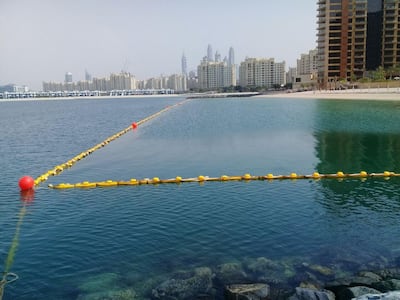Climate change could come with an extra sting in the tale - as warmer weather encourages a rise in numbers of jellyfish in the UAE.
Jellyfish first spotted in the country's waters in September are sticking around much longer than expected - almost until the final weeks of the year - and an environmental expert believes global warming could be part of the reason.
But he is urging sea-goers not to be alarmed, as a surge in jellyfish is a sign of healthy waters, and the majority don't pose any threat.
Although some species can deliver a nasty sting, most do not and should soon be disappearing from the UAE shores into deeper waters.
The large numbers reported in recent weeks have been a barometer of healthy waters, signalling plentiful micro-organisms on which the animals feed.
Changes in water temperatures in spring and winter usually coincide with jellyfish sightings - and 2018 has proved a bumper year.
“Globally, greater populations of jellyfish are associated with climate change, as an increase in water temperatures can increase micro-organisms in the seas on which they feed,” said Ahmed Al Hashmi, director of marine biodiversity division at the Environment Agency Abu Dhabi.
“Jellyfish in the water are a good indicator of healthy seas.
“They feed on different types of microalgae and phytoplankton and provide food for unique species like turtles, so they play a major role in the marine food chain and ecosystem.
“At this time of year, it is not uncommon to see large numbers of jellyfish around the UAE.”

Several species of jellyfish are found in UAE coastal waters, with the blue blubber variant normally seen in April and May.
Upside down and nettle jellyfish, more commonly associated with accidental stings on swimmers, are usually spotted in September and October.
Plentiful numbers well into November, weeks later than they are expected to disappear, could be due to warmer waters, or an indicator of fewer predators like sharks and turtles lying in wait.
“If there are strong winds and currents, the larger jellyfish may get blown into shallow waters or onto beaches,” said Mr Al Hashmi.
“People should not be concerned, but they should also apply common sense and not touch them or swim close by.”
Although jellyfish stings are not uncommon, they can be painful and become serious if it triggers an allergic reaction.
Signs and symptoms are a burning, prickling stinging or pain followed by swelling and throbbing of the area affected.
Usually stings from jellyfish are minor, with nettle jellyfish or those with long tentacles more likely to deliver a severe reaction, and can be treated with antihistamines.
Jellyfish are a common site for scuba divers in the UAE.
“Some of the jellyfish we are seeing now around the coastal area are the blue blubber jelly fish,” said Kathleen Russell, a PADI course director at the Al Mahara Diving Center.
“They have shorter tentacles so they are easier to avoid for scuba divers, and we usually see them when the seasons are changing.”
_____________________
Read more:
Abu Dhabi to study climate change threat facing sea creatures
Dubai’s Jebel Ali recognised as a wetland of global importance
Dubai environment summit told rapid regional growth has come at huge cost
_______________________
Jellyfish nets have been placed around popular bathing spots of the UAE coastline, protecting swimmers on The Palm and Jumeirah in Dubai, and Ajman.
The mesh nets with 50mm gaps are anchored to the ocean bed and require regular maintenance to effectively repel jellyfish back out to sea.
Tom Day, a sales director at EcoCoast, said the company’s eco-barrier jellyfish net is designed not to entangle other sea life and is a sustainable solution to protect the marine environment.

“The net will span from the surface to the sea bed to create a barrier to protect swimmers,” he said.
“We use different materials depending on where they will be placed, but they must be maintained and anchored correctly with a concrete sinker.
“There is a high level of marine growth in the UAE, that can drag the net under and it will fail.
“We don’t want the nets to be left out in the ocean or in landfill.
“They are not as heavy duty as shark nets, but they are very effective and we are getting a lot more enquiries about new installations to protect against increasing numbers of jellyfish.”


